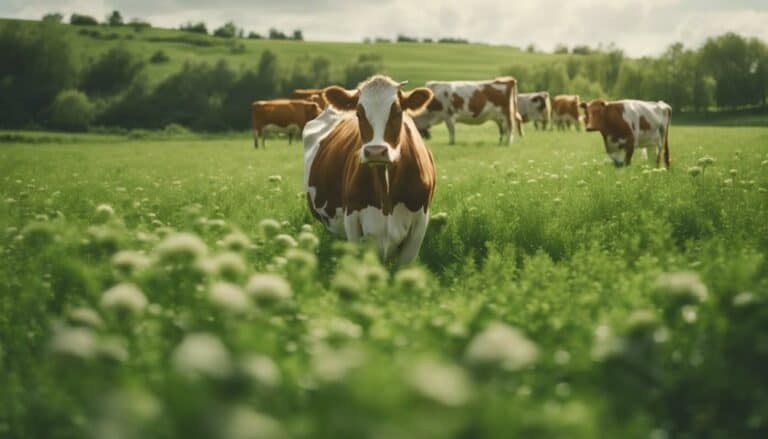When it comes to optimizing grazing systems, integrating forage is a key strategy that can greatly enhance the efficiency and sustainability of your operation. By carefully selecting and managing a variety of forage species, you can not only improve the nutritional quality of your livestock's feed but also foster a more resilient and balanced ecosystem within your pastures. The benefits of incorporating forage into grazing systems go beyond just providing food for your animals; it's a holistic approach that can lead to long-term success and environmental stewardship.
Key Takeaways
- Diverse forage species enhance soil health, biodiversity, and nutrient cycling in grazing systems.
- Rotational grazing with various forages improves forage utilization and ecosystem stability.
- Forages provide high-quality feed, promoting livestock nutrition and well-being.
- Enhanced pasture health through forage integration controls weeds, pests, and diseases.
- Sustainable forage management practices reduce external inputs and enhance soil health in grazing systems.
Enhancing Grazing Systems With Forage
By incorporating diverse forage species, grazing systems can be greatly enhanced with respect to soil health, biodiversity, and nutrient cycling efficiency. Forages play a pivotal role in sustainable grazing practices by providing a source of high-quality feed for livestock while simultaneously benefiting the ecosystem.
Implementing rotational grazing systems that integrate various forage species not only improves forage utilization but also enhances soil health through root diversity and organic matter deposition. This promotes nutrient cycling within the pasture, reducing the reliance on external inputs and creating a more self-sustaining system.
Furthermore, the introduction of diverse forages increases biodiversity within the grazing environment, supporting a wider range of plant and animal species. This enhanced biodiversity can lead to improved resilience against environmental stressors and overall ecosystem stability.
Maximizing Animal Nutrition With Forage
Incorporating diverse forage species into grazing systems can greatly enhance animal nutrition by providing essential nutrients and fiber for livestock, contributing to a balanced diet and excellent performance. Forages play a vital role in meeting livestock's energy, protein, vitamin, and mineral requirements, reducing the dependence on supplemental feeds.
By including a variety of forage plants in pastures, you can make certain that your animals have access to a wide range of nutrients, promoting excellent animal nutrition. Proper grazing management practices are essential to maximize the benefits of forages on animal health and performance. Well-managed forage in grazing systems can improve digestion, overall health, and the performance of livestock.
Utilizing diverse forage species effectively not only enhances the quality and variety of nutrients available to grazing animals but also leads to improved growth, reproduction, and well-being of your livestock. By paying close attention to grazing systems and incorporating a variety of forages, you can achieve outstanding animal nutrition and elevate animal performance.
Improving Pasture Health Through Forage
To enhance pasture health through the integration of diverse forage species, one must consider the beneficial impacts on soil structure, organic matter content, and nutrient cycling. Forage plants play an important role in improving soil organic matter, which enhances soil fertility and promotes nutrient cycling essential for sustainable pasture health.
By incorporating a variety of forage species into grazing systems, you can effectively control weeds, pests, and diseases, leading to healthier pastures and improved livestock nutrition. Moreover, the presence of forage plants aids in carbon sequestration, contributing to climate change mitigation and environmental sustainability within grazing systems.
Implementing well-managed forage rotations not only improves pasture resilience but also supports healthy plant growth and enhances overall grazing system productivity. Embracing the benefits of diverse forage species is key to fostering biodiversity, enhancing pest management, and ensuring the long-term health of your pastures.
Biodiversity Benefits of Forage Integration
Integrating forages into grazing systems greatly enhances biodiversity by fostering a diverse array of plant species essential for wildlife habitats. This practice not only increases plant diversity but also has far-reaching effects on the overall ecosystem.
Here are three key benefits of forage integration:
- Enhanced Soil Health: Forages contribute to improved soil health by increasing microbial diversity and nutrient cycling, which in turn supports a more resilient ecosystem.
- Support for Beneficial Insects: Diverse forage species attract beneficial insects and pollinators, further promoting biodiversity within grazing areas.
- Increased Animal Diversity: By rotating forage crops in pastures, the soil structure improves, leading to a more balanced ecosystem with enhanced animal diversity.
These biodiversity benefits highlight the importance of integrating forages into grazing systems not only for the health of the land but also for the diverse array of flora and fauna it supports.
Sustainable Forage Management Practices
Sustainable forage management practices play a vital role in enhancing soil health, biodiversity, and nutrient cycling within grazing systems. Incorporating diverse forage species not only improves pasture resilience and productivity but also reduces the need for external inputs. Proper grazing management is essential as it decreases soil erosion, enhances water infiltration, and promotes carbon sequestration in grazing systems. Integrated crop-livestock systems with forages foster ecological synergies and sustainable agricultural practices. Rotational grazing systems, when combined with strategic infrastructure, boost forage utilization efficiency and ultimately enhance livestock productivity.
| Sustainable Forage Management Practices | Benefits |
|---|---|
| Diverse forage species | Improves pasture resilience and reduces external input requirements |
| Proper grazing management | Decreases soil erosion, enhances water infiltration, and promotes carbon sequestration |
| Integrated crop-livestock systems | Foster ecological synergies and sustainable agricultural practices |
Conclusion
You've learned how integrating forage into grazing systems can revolutionize your livestock operations and benefit the ecosystem.
But remember, in a world where efficiency is key, sometimes slowing down to embrace the natural cycle of nutrient exchange can yield the greatest rewards.
So, next time you mow down your pastures, consider letting the forage feed the cycle instead.
It's ironic how going back to basics can pave the way for a sustainable future.

